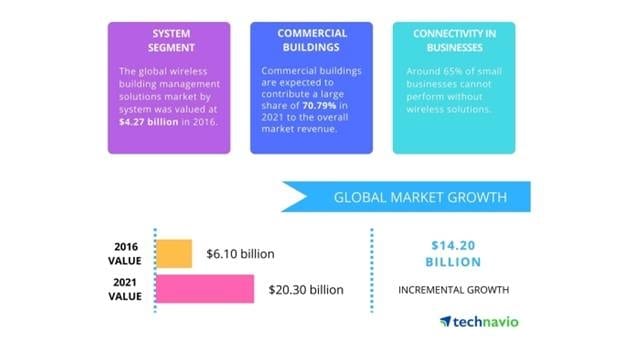The global wireless building management solutions market size is projected to reach USD 20.3 billion by 2021, at a CAGR of more than 27% over the forecast period, according to their latest report by Technavio.
The building management solutions covers set of networks, components, and services that are installed in building facilities to ensure a seamless and reliable indoor coverage. The Americas is the largest adopter of these solutions, driven by rapid developments in the hospitality, retail, and office buildings sectors.
“Wireless technologies have evolved to simplify business operations. Industries now employ M2M services to streamline several aspects of their business processes. For instance, the retail industry uses M2M interactions to assist businesses in executing secured online payments through the point of sale terminals,” says Bharath Kanniappan, one of the lead analysts in Technavio for automation research.
Currently, remote monitoring of M2M solutions is gaining traction with the evolution of wireless management systems. Further, the scope of M2M interaction and connectivity is driving the adoption of wireless communication technology in buildings for effective decision making and performance measurement, thereby driving market growth.
In a building, several assets, such as lighting, heating, ventilation, and air conditioning (HVAC), and access control systems require timely maintenance to ensure a long-life cycle of the asset, leading to the adoption of multi-building management systems. Wireless sensors and controllers are deployed as a part of the building management systems to interlink and network different systems to optimize the real-time operations by using environmental parameters like occupancy, temperature, and lighting. Additionally, cloud-based platforms are deployed to save the data against sudden breakdowns.
“The Internet revolution is fueling ubiquitous connectivity by interlinking devices. The network technology has evolved to meet the needs of different needs and applications, by providing an effective communication infrastructure for the rapid pace of communication among Internet-enabled devices at high speed,” says Bharath.
With the help of wireless solutions, every device or asset within an organization is interconnected with the others through Internet. Also, enterprises are experiencing a significant increase in efficiency in business processes, enabled by closer monitoring of business processes leading to more effective decisions in real-time, said the market research firm.




















